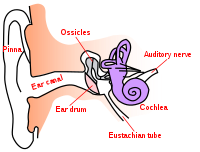
Photo from wikipedia
OBJECTIVE We aimed to investigate whether current levels of total serum bilirubin are associated with different subtypes of sensorineural hearing loss (SNHL) in adolescents. METHODS A set of cross-sectional data… Click to show full abstract
OBJECTIVE We aimed to investigate whether current levels of total serum bilirubin are associated with different subtypes of sensorineural hearing loss (SNHL) in adolescents. METHODS A set of cross-sectional data from the National Health and Nutrition Examination Survey (NHANES) (2007-2010) was used. A subset of 1404 adolescents was sampled for measurements of total serum bilirubin, tympanometry, and average pure tone threshold at low-frequencies (LPTA: 500, 1000, 2000 Hz) or high-frequencies (HPTA: 3000, 4000, 6000, and 8000 Hz). SNHL was defined as the hearing loss that had type A tympanograms with a peak admittance of 0.3 ml or greater. Associations between serum bilirubin (square-root transformed) and different subtypes of SNHL were evaluated using binary or multinomial logistic regression models with 4-year sampling weights. The bootstrap method was used for estimation of variance and 10-fold cross-validation for assessment of overfitting issue. RESULTS Total serum bilirubin levels were found to be associated with any high-frequency (HPTA>15 dB in at least one ear, adjusted odds-ratio (ORa)(bootstrap 95% confidence interval) = 3.29(1.31-8.19), p = 0.011), but not with any low-frequency (LPTA>15 dB in at least one ear), SNHL in the US adolescents. Furthermore, high-frequency SNHL with HPTA>15 dB in both ears (bilateral) or HPTA≥25 dB in at least one ear, compared to that with HPTA>15 dB in one ear only (unilateral) or HPTA = 15-25 dB in at least one ear, had a stronger association with total serum bilirubin levels (ORa = 5.37(1.27-22.65), p = 0.022 for bilateral; ORa = 2.64(0.84-8.25), p = 0.094 for unilateral; ORa = 5.00(0.95-26.58), p = 0.058 for HPTA≥25 dB in at least one ear; as well as ORa = 3.06(1.15-8.25), p = 0.025 for HPTA = 15-25 dB in at least one ear). No severe overfitting problems were found. CONCLUSION Our findings suggest that current levels of total serum bilirubin may be informative in predicting and/or targeting high-frequency SNHL in the US adolescents.
Journal Title: International journal of pediatric otorhinolaryngology
Year Published: 2018
Link to full text (if available)
Share on Social Media: Sign Up to like & get
recommendations!